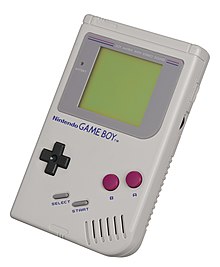
Back Game Boy AN غيم بوي Arabic جيم بوى ARZ Game Boy AST Game Boy Byelorussian Game Boy BS Game Boy Catalan گەیم بۆی CKB Game Boy Czech Game Boy Danish
 An original Game Boy | |
| Also known as | DMG-01
|
|---|---|
| Developer | Nintendo R&D1 |
| Manufacturer | Nintendo |
| Product family | Game Boy[1] |
| Type | Handheld game console |
| Generation | Fourth |
| Release date | |
| Lifespan | 14 years |
| Introductory price | |
| Discontinued | March 31, 2003 |
| Units sold | 118.69 million (including all variants and Game Boy Color)[8] |
| Media | Game Boy Game Pak |
| System on a chip |
|
| CPU | Sharp SM83 @ 4 MHz |
| Memory | 8 KB RAM, 8 KB VRAM |
| Display | |
| Best-selling game | Tetris (40 million units)[9] |
| Predecessor | Game & Watch |
| Successor | Game Boy Color[10] |
The Game Boy is an 8-bit, fourth generation, handheld game console developed by Nintendo, launched in the Japanese home market on April 21, 1989, followed by North America and Europe later that year. Designed by the team behind the Game & Watch handhelds and NES games (Satoru Okada, Gunpei Yokoi, and R&D1), it was Nintendo's first portable console, combining features from both.
The Game Boy features a dot-matrix screen with adjustable contrast, a directional pad, four game buttons, a single monaural speaker with volume control, and uses Game Pak cartridges. The two-toned gray design with black, blue, and dark magenta accents sported softly rounded corners, except for the bottom right which was curved. At launch, it was sold either as a standalone unit, or bundled with games like Super Mario Land and Tetris, with accessories like carrying pouches, a camera, and a printer available.
Despite mixed reviews criticizing its monochrome graphics and larger size compared to competitors like the Sega Game Gear, Atari Lynx, and NEC TurboExpress, the Game Boy rapidly outsold them all. An estimated 118.69 million units of the Game Boy and its successor, the Game Boy Color (1998), have been sold worldwide, making it the fourth best-selling console ever. A cultural icon of the 1990s, the Game Boy received several redesigns during its lifespan, including the smaller Game Boy Pocket (1996) and the backlit Game Boy Light (1998). Sales of Game Boy variants continued until 2003.
- ^ Ishihara; Morimoto. "Pokémon HeartGold Version & Pokémon SoulSilver Version". Iwata Asks (Interview: Transcript). Interviewed by Satoru Iwata. Nintendo. Archived from the original on November 24, 2022. Retrieved September 25, 2022.
- ^ White, Dave (July 1989). "Gameboy Club". Nintendo Power. No. 7. p. 84.
- ^ "retrodiary: 1 April – 28 April". Retro Gamer. No. 88. Bournemouth: Imagine Publishing. April 2011. p. 17. ISSN 1742-3155. OCLC 489477015.
- ^ "Video Games Around the World: South Africa". Archived from the original on September 25, 2022. Retrieved November 10, 2022.
- ^ a b "Happy 20th b-day, Game Boy: here are 6 reasons why you're #1". Ars Technica. September 7, 2015. Archived from the original on August 15, 2017. Retrieved June 14, 2017.
- ^ "The Real Cost of Gaming: Inflation, Time, and Purchasing Power". October 15, 2013. Archived from the original on September 15, 2020. Retrieved August 28, 2020.
- ^ "Console Crazy!". ACE. No. 37. September 1990. p. 142. Archived from the original on April 1, 2024. Retrieved April 1, 2024.
- ^ "Consolidated Sales Transition by Region" (PDF). Nintendo. April 26, 2016. Archived from the original (PDF) on April 27, 2016. Retrieved October 23, 2016.
- ^ Takahashi, Dean (June 1, 2009). "After 25 years, Tetris has sold 125 million copies". VentureBeat. Archived from the original on June 21, 2023. Retrieved June 21, 2023.
- ^ Umezu; Sugino. "Nintendo 3DS (Volume 3 – Nintendo 3DS Hardware Concept)". Iwata Asks (Interview: Transcript). Interviewed by Satoru Iwata. Nintendo. Archived from the original on July 25, 2015. Retrieved March 20, 2013.
© MMXXIII Rich X Search. We shall prevail. All rights reserved. Rich X Search